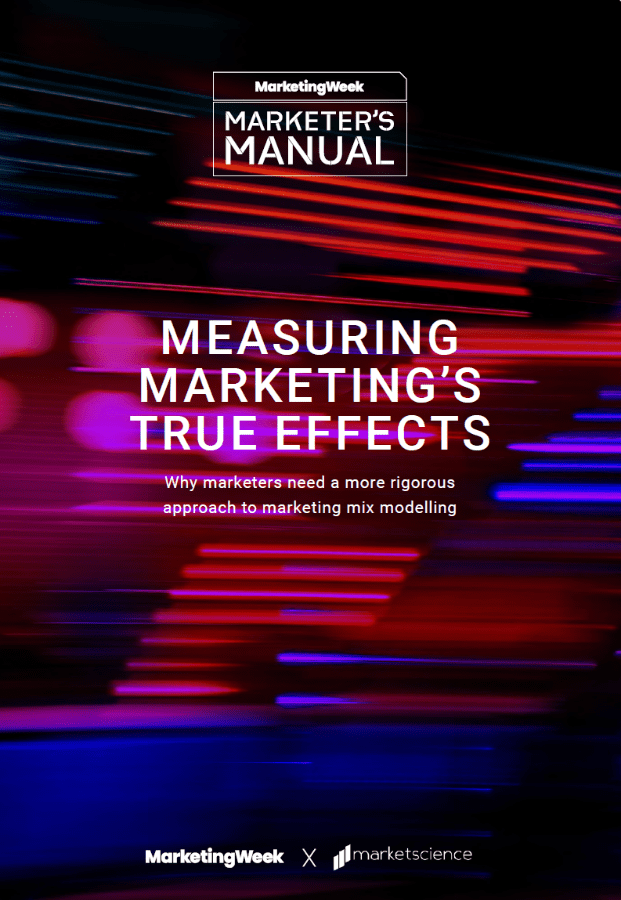As the first piece of research to be published in Marketing Week Marketer’s Manual, Marketscience provides a strong point of view around the pitfalls of today’s marketing mix modeling techniques and puts forward a new, more rigorous approach.
Pitfalls of today’s MMM approaches

A misattribution issue: In attempting to reflect a consumer’s path to purchase, many marketing mix models fail to address the inherent ‘selection bias’ in much online media. For example, consumers with a greater propensity to buy predict a higher level of search traffic, which in turn predicts the sales outcome. In this way, a large proportion of website visits are simply an artefact of the sales process.
Such misattribution leads to misleading budget allocation recommendations for marketers.
A long-term brand measurement issue: Standard MMM approaches are short-term focused by construction, with no mechanism for evaluating how advertising works to build persistent brand equity. Conventional remedies for this fall into three broad areas: multiplying the short-term effects by a simple scaling factor; dual Adstocks, where the same media data enters the model twice with short and long decay rates; augmenting the sales equation with brand equity metrics, where the indirect effects of advertising on sales are then interpreted as long-term effects.
However, none of these techniques adequately captures the true nature of brand-building.
- Scaling factors simply assume long-term effects exist, bearing no relation to the data at hand.
- The dual Adstock approach is entirely ad hoc: not only does it raise questions over where short-term effects end and long-term effects begin but the extremely high retention rates used to mimic brand building essentially imply persistent evolution in the sales data. This requires a completely different time-series approach to the marketing mix model if it is to avoid potentially serious bias in the claimed brand-building effects.
- Adding brand equity metrics to the short-term sales equation makes little sense: the indirect effects are interpreted as long-term effects simply because attitudinal brand metrics are defined as long-term constructs. However, if attitudinal metrics are to form the basis of a robust theory of brand-building, they need to link directly to any evolution in underlying baseline sales. If there is no (observed) long-term evolution, then the effect is not a long-term effect.
A more rigorous approach
To alleviate these issues and enable more accurate marketing effectiveness analysis and optimization, Marketscience has put forward a new, academically and commercially grounded MMM methodology comprising two key steps:
- A short-term model based on Unobserved Component Modelling (UCM) techniques, with adjustment for selection bias. This provides an accurate split into short-term incremental volumes and long-term base sales evolution.
- A dynamic brand-building model, quantifying the drivers of long-term base sales evolution in terms of brand metrics, and paid and earned media. These are then combined with short-term effects from the UCM to provide total ROI and budget allocation recommendations.
The result is a practical modelling system for marketing mix practitioners with a rigorous economic and statistical foundation for short and long-term advertising effects.
Benefits for marketers
This new approach offers advertisers strategic benefits for planning and executing both brand and performance marketing:
- Firstly, marketers get a more comprehensive view of the path to purchase and the short-term role of marketing – this is critical for accurately measuring short-term ROI and optimizing spend across channels for sales growth.
- Secondly, marketers also get a more credible view of the long-term sales contribution of brand building and which brand metrics matter. Not only can this be used to build a more credible business case to justify long-term marketing plans, but also to determine which brand perceptions and attitudes their advertising needs to create among consumers.
Advertisers working with Marketscience across a number of industries have already benefited from the new modeling technique. It has provided not only insights around marketing and creative executions but also sales and operational decisions such as pricing, promotion, customer experience and distribution.
To read the full Marketer’s Manual piece, click here.
To learn more about how this approach can benefit your business, please contact us.



How does the Unobserved Component Modelling (UCM) technique help in accurately distinguishing between short-term incremental volumes and long-term base sales evolution?
Tel U
The UCM form with explanatory variables is a (constrained) seasonal ARIMAX model – and splits the sales data into core time series components: season, a long-term trend component, a short-term MA component and short-term regression effects. The evolving trend component (if it exists) equates to the model baseline – separated from the (short-term) regression effects. The sales decomposition process then converts these estimates into (evolving) baseline volumes and short-term (incremental) volumes.